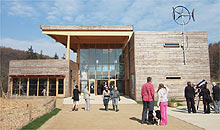An £82m plant research centre at the University of Cambridge has won the UK’s most prestigious architecture award, the Stirling Prize.
The Sainsbury Laboratory was named best new building by the Royal Institute of British Architects (Riba) at a ceremony in Manchester.

Judges praised the “calm beauty” of the winner, designed by Stanton Williams.
It beat nominees including London’s Olympic Stadium and the Hepworth art gallery in Wakefield, West Yorkshire.
The other buildings on the shortlist were Belfast’s Lyric Theatre, the Maggie’s cancer care centre in Glasgow and New Court, the home of the Rothschild bank in the City of London.
The two-storey Sainsbury Laboratory sits on the edge of the University of Cambridge’s botanic gardens and provides state-of-the-art facilities for 120 botanists carrying out research into plant development.
Stirling Prize judge and architect Joanna van Heyningen described it as an “extraordinarily good building”.
The researchers “deserve the best possible space in which to work, and that’s what they’ve been given”, she told BBC News.
“It’s a completely sublime building with the most extraordinary, beautifully designed natural light,” she added.
The site was funded by Lord Sainsbury, a former science minister and ex-chairman of the Sainsbury’s supermarket, who said scientists had traditionally had to put up with “appalling” buildings.
Stanton Williams received a £20,000 prize. Director Alan Stanton described the design as a 21st Century cloister, which encouraged scientists to interact and exchange ideas.
“Two scientists working on two pieces of research could bump into each other in the corridor and have a eureka moment, and say, my God, there’s the possibility of some really interesting scientific breakthrough here,” he said.
“Quite often, accidents are important, in science as they are in any creative endeavour. The building is there to try to ambush scientists into meeting and talking.”
Stanton Williams was the only practice to have three buildings on the longlist for this year’s Stirling Prize.
Its other entries were the Hackney Marshes Centre in east London and the new campus for Central Saint Martins College of Arts and Design at King’s Cross.
The practice has previously built the Compton Verney art gallery in Warwickshire and the Millennium Seed Bank in Wakehurst, West Sussex.
‘Dreadful’ state
The Olympic Stadium lost out despite being one of the most high-profile buildings of the year.
The Stirling Prize is awarded to the best building constructed in the European Union and designed in the UK.
The Olympic Stadium was the most high-profile structure on the shortlist – but it missed out one year after the Olympic velodrome lost out on the same award.
Last year’s winner was the Evelyn Grace Academy, a secondary school in Brixton, south London, designed by Zaha Hadid Architects.
This year’s ceremony came after two judges were reported as saying that British architecture was in a “dreadful” state.
Sir Mark Jones told The Independent newspaper there was a “lack of feeling and lack of care” in many retail, residential and office developments, while fellow judge and Naomi Cleaver said local authorities were “rather unfocused and arbitrary” in their decision making.
Taken from: http://www.bbc.co.uk/news/entertainment-arts-19923820




